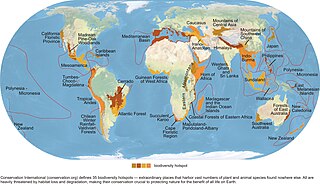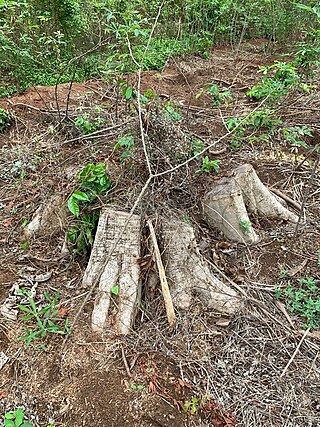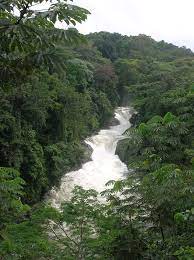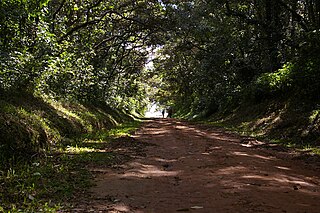
Deforestation or forest clearance is the removal and destruction of a forest or stand of trees from land that is then converted to non-forest use. Deforestation can involve conversion of forest land to farms, ranches, or urban use. About 31% of Earth's land surface is covered by forests at present. This is one-third less than the forest cover before the expansion of agriculture, with half of that loss occurring in the last century. Between 15 million to 18 million hectares of forest, an area the size of Bangladesh, are destroyed every year. On average 2,400 trees are cut down each minute. Estimates vary widely as to the extent of deforestation in the tropics. In 2019, nearly a third of the overall tree cover loss, or 3.8 million hectares, occurred within humid tropical primary forests. These are areas of mature rainforest that are especially important for biodiversity and carbon storage.

Habitat destruction occurs when a natural habitat is no longer able to support its native species. The organisms once living there have either moved to elsewhere or are dead, leading to a decrease in biodiversity and species numbers. Habitat destruction is in fact the leading cause of biodiversity loss and species extinction worldwide.

Environmental issues in Haiti include a historical deforestation problem, overpopulation, a lack of sanitation, natural disasters, and food insecurity. The major reasons for these environmental issues are corruption, human exploitation, and the embezzlement of taxpayers' funds for personal gains. In addition, there is not sufficient protection or management of the country's natural resources. Other environmental issues, such as decreases in precipitation and more severe natural disasters, will likely arise in Haiti as a result of climate change. Experts agree that Haiti needs to adopt new policies to address both the issues that already exist and to prepare for the effects of climate change.
The Lower Guinean forests also known as the Lower Guinean-Congolian forests, are a region of coastal tropical moist broadleaf forest in West Africa, extending along the eastern coast of the Gulf of Guinea from eastern Benin through Nigeria and Cameroon.

The extensive and rapid clearing of forests (deforestation) within the borders of Nigeria has significant impacts on both local and global scales.

Defaunation is the global, local, or functional extinction of animal populations or species from ecological communities. The growth of the human population, combined with advances in harvesting technologies, has led to more intense and efficient exploitation of the environment. This has resulted in the depletion of large vertebrates from ecological communities, creating what has been termed "empty forest". Defaunation differs from extinction; it includes both the disappearance of species and declines in abundance. Defaunation effects were first implied at the Symposium of Plant-Animal Interactions at the University of Campinas, Brazil in 1988 in the context of Neotropical forests. Since then, the term has gained broader usage in conservation biology as a global phenomenon.

Malaysia faces several environmental issues. Malaysia's environment possesses megadiverse biological diversity, with globally significant endemism and biodiversity, but is threatened by several issues. Deforestation is a major issue in the country that has led to many species becoming threatened with extinction. As a major economic sector, palm oil production has had a substantial environmental impact. Air pollution is also a major issue, with the country one of the most affected countries by seasonal Southeast Asian haze. The country is also affected by climate change.
Like other island nations, Antigua and Barbuda faces unique environmental issues created by its proximity to the ocean, and small size. These include pressures on drinking water resources, natural ecosystems, and deforestation more generally.

Oba Hills National Park is a forest reserve and national park in Iwo, Osun State, Nigeria. A small enclave surrounded by three hills with a wide valley running in between, it covers about 52 square kilometres of hilly terrain with deep gorges. It has a large teak plantation on its western side, covering about 12% of its total area. Beyond the hills; only coppices are left on the over-exploited plantation.

Kenya's forests are fragmented across the country. Combined, forests cover over 37 million hectares. Out of those 37 million hectares, 2.1 million are woodlands, 24.8 million are bush lands and 10.7 are wooded grasslands. Kenya's forests are important at a global level as they host 1847 species of amphibians, birds, mammals, and reptiles of which 4% are only found in Kenya. Beyond its fauna, Kenya's forest also hosts 6505 types of vascular plants, with 4.1% only being found in Kenya. Today Kenya faces high rates of deforestation which endanger both its fauna and flora. It has been estimated that since Kenya's independence in 1963, the forest cover has dropped from 10% of the nation to 6%, losing approximately 12,000 hectares annually. These levels of deforestation have impacted Kenya as they rely on the forest for the storage of rainwater, the prevention of flooding, the fertility of the soil, and the regulation of climate conditions. The World War II period and its aftermath made it clear to British colonial administration that reform was needed to sustain Kenyan forests. One of the first steps for conservation took place with the 1941 revision of the Forest Ordinance that passed legislation to create forest reserves and create a committee with professionals on matters of conservation. By 1950, the forest department had gained control of 100,000 acres, but it had a difficult time sustaining the conservation of these areas; it required meaningful policy to meet the constant attention these areas needed.
Cuba possesses a diverse range of natural habitats, housing a wide variety of species, including many endangered ones. However, the country has faced environmental challenges, particularly deforestation, since the arrival of European settlers. Forest areas have been cleared for agricultural purposes, leading to the loss of forests and the extinction of certain species. The cutting down of trees for fuel and construction materials has further contributed to this issue.
There are a number of known environmental issues in the post-communist country of Albania. Issues include air and water pollution, poor waste management infrastructure and deforestation. The Albanian environmental movement includes around 40 active non-government organisations.

William F. Laurance, also known as Bill Laurance, is Distinguished Research Professor at James Cook University, Australia and has been elected as a Fellow of the Australian Academy of Science. He has received an Australian Laureate Fellowship from the Australian Research Council. He held the Prince Bernhard Chair for International Nature Conservation at Utrecht University, Netherlands from 2010 to 2014.

Environmental issues in Liberia include the deforestation of tropical rainforest, the hunting of endangered species for bushmeat, the pollution of rivers and coastal waters from industrial run-off and raw sewage, and the burning and dumping of household waste.
Laos is increasingly suffering from environmental problems, with deforestation a particularly significant issue, as expanding commercial exploitation of the forests, plans for additional hydroelectric facilities, foreign demand for wild animals and nonwood forest products for food and traditional medicines, and a growing population all create increasing pressure.

Linear infrastructure intrusions into natural ecosystems are man-made linear infrastructure such as roads and highways, electric power lines, railway lines, canals, pipelines, firebreaks, and fences. These intrusions cause linear opening through the habitat or breakage in landscape connectivity due to infrastructure creation and maintenance, which is known to have multiple ecological effects in terrestrial and aquatic ecosystems. These effects include habitat loss and fragmentation, spread of invasive alien species, desiccation, windthrow, fires, animal injury and mortality, changes in animal behaviour, pollution, microclimate and vegetation changes, loss of ecosystem services, increased pressures from development, tourism, hunting, garbage disposal, and associated human disturbances. These intrusions, considered crucial infrastructure for economic sectors such as transportation, power, and irrigation, may also have negative social impacts on indigenous and rural people through exposure to novel social and market pressures, loss of land and displacement, and iniquitous distribution of costs and benefits from infrastructure projects. The study of the ecological effects of linear infrastructure intrusions has spawning sub-fields of research such as road ecology and railroad ecology.
Senegal's environmental issues are varied. According to the CIA world factbook pressing problems exist with: diminishing wildlife populations which are threatened by poaching, deforestation, overgrazing, soil erosion, desertification, and overfishing.
Environmental issues in the Democratic Republic of the Congo are the consequence of compounding social and economic problems, including lack of access to clean energy, clearing of lands for agriculture and economic development, and armed conflict. Major environmental issues in DRC include deforestation, poaching, which threatens wildlife populations, water pollution and mining.

The Niger Delta swamp forests is a tropical moist forest ecoregion in southern Nigeria. It consists of freshwater swamp forests in the Niger Delta of the Niger River. This swamp forest is the second largest in Africa after the Congolian swamp forests. Although there are large cities just outside the ecoregion, the area has been relatively isolated by the difficulty of building roads across the swamps, although this is changing with development of oil and logging industries. Scientific surveys have only begun in recent years, and new species were being identified into the 1990s. Crude oil exploration and pollution has been a threat to forests in the Niger Delta region.
Nadine Therese Laporte is a researcher and academic in the fields of forestry and remote sensing.












